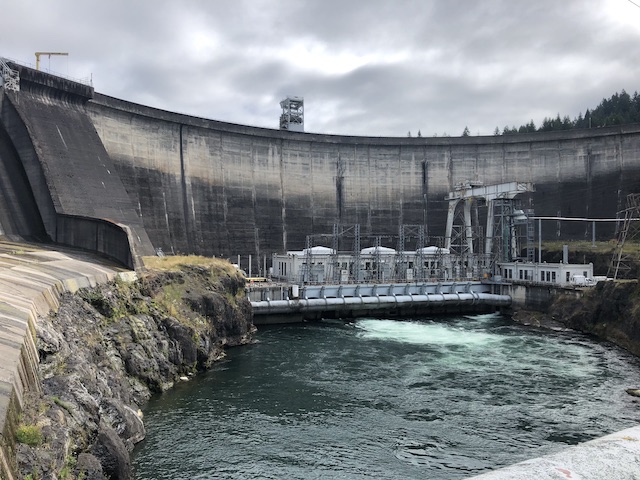by Jennifer Runyon, Content Director
On Tuesday, July 23, about 30 HydroVision attendees had to privilege of touring the 136-MW Lewis River hydropower plant located at the Merwin Dam in Ariel, Washington. The dam was constructed in 1931 and has four penstocks, which today feed three turbines. The turbines were installed in 1931, 1949 and 1958, respectively. The fourth penstock, which was the focus of much of the tour, is for fish passage.
 Tour attendees cross the bride over the Lewis River.
Tour attendees cross the bride over the Lewis River.
In 2008, FERC renewed PacifiCorp’s license to operated and ordered the utility to provide downstream passage at Merwin Dam for the Chinook, Coho, and Steelhead. Today, through a $50 million project, the fish travel through a complicated yet elegant system of “chutes and ladders” finally landing in a sorting pond, where biologists count, tag and sort, by hand, the different species into holding tanks. Trucks then deliver the fish to various locations downstream where they are released. Certain species of the fish go to hatcheries to help the population increase.
 Workers hand-sort all of the fish that pass through the dam.
Workers hand-sort all of the fish that pass through the dam.
The controls for the sorting facility were designed by Bruce Benson of Black and Veatch (sponsor of the tour). Benson attended the tour to help answer questions from attendees. He said that from April to December in the first year of operation 31,994 fish were hand-sorted by the facility.
“I designed the control system part of it, turning the pumps on, a typical pump turbine, valves, operation, things like that,” Benson explained on the bus ride to Ariel.
“It’s kind of unique thinking about limit switches for chutes on tanks to fill the truck, how the water flows from the tank to the truck to keep from dumping [the fish] into an empty truck,” he added.
The facility helps PacifiCorp remain compliant with the FERC order and prove that there is at least an 80 percent survivability rate for the fish that pass through the dam.
Todd Olson, Director of Compliance for PacifiCorp served as tour guide and explained why the four h’s are important.
“In recovering salmon and steelhead here in the Pacific Northwest, we need to address the four H’s: harvest, habitat, hatcheries and hydro. All four have had historic impacts and each have an opportunity to address those impacts. Collectively we can all do our part.”
A video of the tour, produced by Clarion Energy, should be on the website later this summer.




